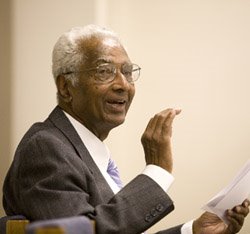In condemning the Vedantin, Samkhya, and Buddhist as extremists, the Jaina is not saying that their views are totally wrong. In fact he will admit that these views are valid when seen as nayas, or partial expressions of truth; they become false only when considered to possess an absolute exclusive validity.
The eternalist takes what the Jaina calls a synthetic view (sangrahanaya) of reality;
the non-eternalist adopts an analytical standpoint (rjusatra-naya - "straight thread", or pinpoint view).
For the Jaina, both positions are partially valid and must be accorded an equal place in describing the existent.
Jainism maintains that an existent may simultaneously be both eternal (as substance) and non-eternal (as modes), but that it can be fully described only in a sequential order; the emphasis of the speaker (vivaksa) will then determine which particular aspect receives precedence.
To describe the multidimensional existent solely as eternal or noneternal would be to deny the other aspects not expressly stated by the speaker.
The Jaina recognizes this unavoidable limitation of language and seeks to overcome it by a device known as syadvada, according to which a statement' is correct only when it is qualified by the indeclinable syat, reinforced by another indeclinable eva.
Syat ordinarily has the optative sense of "might be" but in the Jaina usage is best rendered as “in some respect”. The further addition of eva (in fact) to an assertion qualified by syat gives that assertion a certain necessary emphasis: that is, it is this particular perspective on reality (of the several which syat implies) that the speaker has chosen to adopt.
Thus the statement "the soul is eternal", when read with syat and eva, would mean:
"In some respect - namely, that of substance and not of modes - the soul is in fact eternal."
By qualifying the statement in this manner, the Jaina not only makes a meaningful assertion, but leaves room for other possible statements (for example, "it is not eternal") that can be made about the soul.
This "balancing act" between two (or many) alternatives (nayas) in order to get at the truth is pictured as analogous to churning curds in order to obtain butter, the Indian milkmaid, rope in hand, draws one end taut as she slackens the other.
 Padmanabh S. Jaini
Padmanabh S. Jaini



